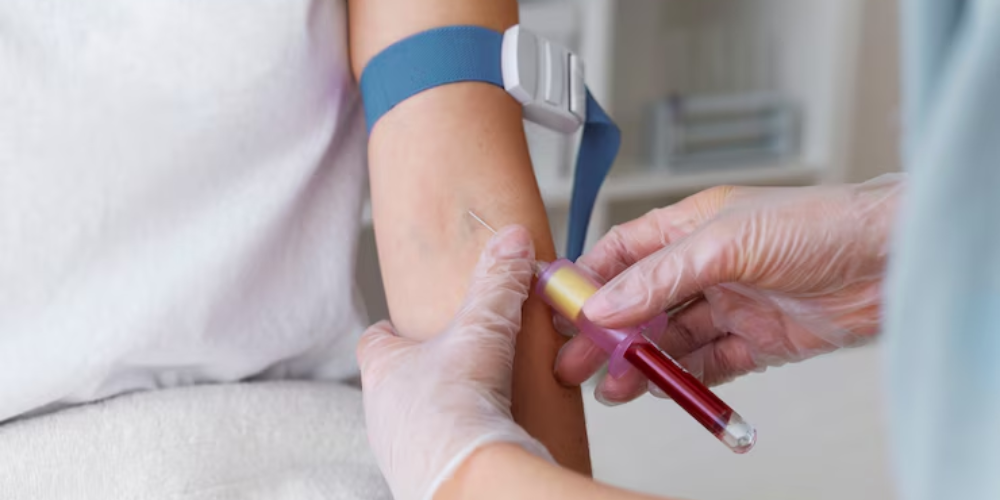
Can You Work Out After Getting Blood Drawn?

A blood draw is a common procedure in healthcare, often used to monitor health or screen for various conditions. While it’s generally a quick and straightforward process, a common question many people have is, “Can you work out after getting blood drawn?”
Understanding how to safely return to exercise after a blood draw is important for maintaining overall health and fitness.
What Happens During a Blood Draw?
A blood draw involves extracting a small amount of blood from a vein, typically using a needle and syringe. This sample is then analyzed to provide insights into various health indicators. For routine tests, only a small volume is needed—often just a few milliliters. Larger quantities are taken during blood donations, which can be up to 500 milliliters.
Common Reactions After a Blood Draw

Pexels | FRANK MERIÑO | Blood donation can cause temporary fatigue and light bruising at the puncture site.
After a blood draw, some people might experience mild dizziness, lightheadedness, or slight bruising at the puncture site. These effects are usually short-lived and not severe. However, the impact on physical performance can vary depending on the volume of blood taken and individual health factors.
Can You Work Out After Getting Blood Drawn?
Exercising after a blood draw is generally safe but depends on several factors. Here’s what to keep in mind:
Factors to Consider
- Amount of Blood Drawn – Small amounts typically have minimal impact on exercise tolerance. Larger draws, such as those from blood donations, can affect stamina and energy levels.
- Personal Health and Fitness – Overall health, fitness level, and any pre-existing conditions play a crucial role in determining when it is safe to resume physical activity.
Safe Exercise Guidelines
- Routine Blood Tests – For small blood draws, light exercises like walking, stretching, or yoga can generally be resumed after a short rest.
- Avoiding Intense Workouts – After a significant blood draw or donation, it’s wise to avoid heavy lifting or intense workouts for the remainder of the day. Engaging in strenuous exercise too soon can lead to increased dizziness or fatigue.
Recovery and Replenishment

Freepik | Iron-rich foods such as red meats, poultry, and spinach are important for recovery after a blood draw.
The body typically replaces blood volume within hours to a day after a routine draw. However, complete recovery might take longer, especially for larger volumes. Here are some tips to help with replenishment:
1. Hydration
Drink plenty of water to support blood volume restoration. Adequate hydration helps to restore plasma levels efficiently.
2. Nutrition
Consuming iron-rich foods (such as red meats, poultry, and spinach) and foods high in vitamin C (like oranges and bell peppers) can aid in the replenishment of red blood cells. Including folate-rich foods and adequate protein supports overall recovery.
Tips for Staying Strong Post-Blood Draw
To ensure a smooth recovery and maintain energy levels:
- Hydrate Adequately – Aim for 8-10 glasses of water daily, especially post-draw.
- Balanced Diet – Incorporate a variety of nutrients to aid in recovery.
- Gradual Return to Exercise – Start with light activities and progressively increase intensity.
- Listen to Your Body – Rest if feeling unwell, and seek medical advice if experiencing unusual symptoms.
The question of – can you work out after getting blood drawn? can be answered with a clear yes, with considerations. It’s crucial to gauge individual comfort and recovery while following these guidelines for a safe return to exercise.
More in Fitness
-
`
Hair & Makeup Designer Sarah Rubano Talks Turning Mia Goth Into Pearl
Transforming an actor into an unrecognizable character is no small feat, and Mia Goth’s Pearl makeup in the hit movie “Pearl”...
December 17, 2024 -
`
The Physical Signs of Hunger and How Mindful Eating Makes a Difference
Hunger is one of the most basic yet essential signals our body uses to communicate its need for energy. However, many...
December 15, 2024 -
`
Why Did Chris Pratt Call Anna Faris Before Proposing to Katherine?
Chris Pratt, the beloved star of “Guardians of the Galaxy,” made headlines when he revealed that he called his ex-wife, Anna...
December 3, 2024 -
`
6 Proven Tips to Tackle Insurance Claim Denials Successfully
Claim denials are a common hurdle for healthcare providers and professionals, even for those who follow the necessary procedures to avoid...
December 1, 2024 -
`
5 ‘Bad’ Fitness TikTok Trends You Shouldn’t Follow
TikTok has become a haven for creative fitness advice. But not all trends are worth your time or your health. From...
November 23, 2024 -
`
Does Drinking Water Affect Adrenal Hormones?
Drinking water is often seen as a simple way to stay hydrated, but it has deeper effects on our body than...
November 14, 2024 -
`
Why We Feel the Loss of Celebrities So Deeply?
Celebrity grief might sound strange at first. After all, most of us have never met these famous figures in person, yet...
November 5, 2024 -
`
Are High Deductible Insurance Plans as Ideal as They Appear to Be?
High deductible insurance plans have been a hot topic for years, especially as healthcare costs continue to rise. For many Americans,...
October 31, 2024 -
`
How Training Load Data Can Transform Your Exercise Routine
Tracking progress during workouts is challenging. Simple metrics like mileage or time don’t show the whole picture. Understanding the overall effort...
October 26, 2024















You must be logged in to post a comment Login